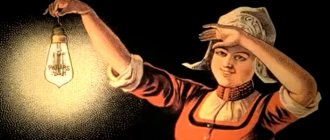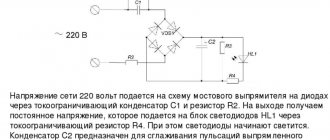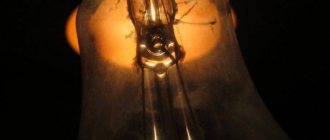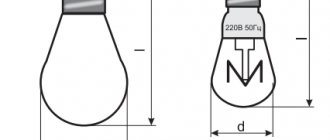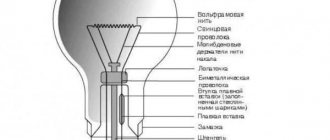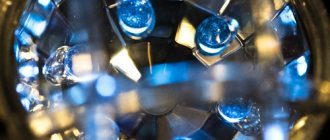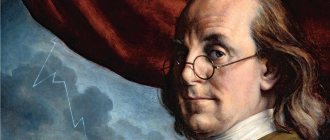There is a lot of talk and unfounded controversy surrounding this issue. Who invented the incandescent lamp? Some claim that this is Lodygin, others that Edison. But everything is much more complicated, let's look at the chronology of historical events.
There are many methods for transforming electrical energy into light. These include lamps of the arc principle of operation, gas-discharge and those where the source of luminescence is a heating filament. In fact, an incandescent light bulb can also be considered an artificial light source, since its operation uses the effect of a heated conductor through which current passes. The heated element is most often a metal spiral or a carbon filament. In addition to the conductor, the design of the light bulb includes a bulb, a current lead, a fuse and a base. However, we already know all this now. But not so long ago there was a time when several scientists carried out simultaneous developments in the field of artificial light sources and competed for the title of inventor of the light bulb.
Timeline of invention
Reading the entire article below, it is very convenient to look at this table:
| 1802 | Electric arc by Vasily Petrov. |
| 1808 | Humphry Davy described an electrical arc between two carbon rods, creating the first lamp. |
| 1838 | Belgian inventor Jobart created the first incandescent lamp with a carbon core. |
| 1840 | Warren de la Rue created the first light bulb with a platinum filament. |
| 1841 | The Englishman Frederic de Moleyn patented a lamp with a platinum filament and carbon filling. |
| 1845 | King replaced the platinum element with carbon. |
| 1845 | The German Heinrich Goebel created the prototype of the modern light bulb. |
| 1860 | Englishman Joseph Swan (Swan) received a patent for a lamp with carbon paper. |
| 1874 | Alexander Nikolaevich Lodygin patented a lamp with a carbon rod. |
| 1875 | Vasily Didrikhson improved Lodygin's lamp. |
| 1876 | Pavel Nikolaevich Yablochkov created a kaolin lamp. |
| 1878 | English inventor Joseph Wilson Swan patented a carbon fiber lamp. |
| 1879 | American Thomas Edison patented his lamp with a platinum filament. |
| 1890 | Lodygin creates lamps with incandescent filaments from tungsten and molybdenum. |
| 1904 | Sandor Just and Franjo Hanaman patented a lamp with a tungsten filament. |
| 1906 | Lodygin launched lamp production in the USA. |
| 1910 | William David Coolidge perfected the method of producing tungsten filaments. |
If you want to really understand, we strongly recommend reading the entire article.
The first conversions of energy into light
In the 18th century, a significant discovery occurred, which marked the beginning of a huge series of inventions. An electrical current was detected. At the turn of the next century, the Italian scientist Luigi Galvani invented a method for producing electric current from chemicals - a voltaic column or galvanic cell. Already in 1802, physicist Vasily Petrov discovered the electric arc and proposed using it as a lighting device. Four years later, the Royal Society saw Humphry Davy's electric lamp; it illuminated the room due to the sparks between the coal rods. The first arc lamps were too bright and expensive, making them unsuitable for everyday use.
Lamps before the advent of the electric counterpart.
Man has been looking for ways to illuminate at night ever since he became Homo sapiens. If at the equator the daylight hours are quite long, then in the northern latitudes in winter it is only 6-7 hours. A man is not a bear, he cannot sleep for the remaining 16-17 hours. There was only one technology for lighting homes all over the world in the pre-electric era: fire . At first it was just a fire in a cave. Then, as civilization progressed and the way of life became more complex, prototypes of lamps began to appear. A suitable composition was poured into a fireproof container and a fabric wick was placed. In different countries, different liquids were used for these purposes: fats, vegetable and mineral oils, natural gas. Such lamps were a fire hazard and smoked mercilessly. And the light from them was very dim.
In the Middle Ages, beeswax candles were invented. They smoked less. The use of a large number of candles allowed the rooms to be well illuminated. But the fire danger did not go away - it was necessary to extinguish them in time. Naturally, the use of a large number of candles was available only to wealthy aristocrats or philistines. Commoners still had to be content with the dim light of a wax candle or kerosene lamp.
Incandescent lamp: prototypes
The first development of incandescent lighting lamps began in the mid-19th century. Thus, in 1838 the Belgian inventor Jobart presented a design for an incandescent lamp with a carbon core. Although the operating time of this device did not exceed half an hour, it was evidence of technological progress in this field. In 1840 , Warren de la Rue, an English astronomer, produced the platinum filament light bulb, the first filament helical lamp in the history of electrical engineering. The inventor passed an electric current through a vacuum tube containing a coil of platinum wire. As a result of heating, the platinum emitted a bright glow, and the almost complete absence of air made it possible to use the device in any temperature conditions. Due to the high cost of platinum, it was illogical to use such a lamp for commercial purposes, even taking into account its efficiency. However, later it was the sample of this light bulb that began to be considered the ancestor of other incandescent lamps. Warren de la Rue several decades later (in the 1860s ) began to actively study the phenomenon of gas-discharge glow under the influence of current.
In 1841 , the Englishman Frederick de Moleyn patented lamps, which were flasks with a platinum filament filled with carbon. However, his tests on conductors in 1844 were unsuccessful. This was due to the rapid melting of the platinum filament. In 1845, another scientist, King, replaced platinum incandescent elements with carbon sticks and received a patent for his invention. During these same years, overseas, in the USA, John Starr patented a light bulb with a vacuum sphere and a carbon burner.
In 1854 , the German watchmaker Heinrich Goebel came up with a device that is considered the prototype of modern light bulbs. He demonstrated it at an electrical exhibition in the USA. It was an incandescent vacuum lamp that was truly suitable for use in a wide variety of conditions. As a light source, Heinrich suggested using a bamboo thread that was charred. Instead of the flask, the scientist took simple bottles of eau de toilette. The vacuum in them was created by adding and pouring mercury from the flask. The disadvantage of the invention was its excessive fragility and operating time of only a few hours. During the years of his active research life, Goebel was unable to meet due recognition in society, but at the age of 75 he was named the inventor of the first practical incandescent lamp based on a carbon filament. By the way, it was Goebel who first used lighting partings for advertising purposes: he rode around New York in a cart decorated with light bulbs. A telescope was installed on the wheelchair, which attracted attention from afar, through which the scientist allowed him to look at the starry sky for a fee.
Why can't a light bulb have just one inventor?
The fact is that in the 19th century, scientists from different countries of the world experimented with electricity, and they all knew very well that some materials begin to glow when exposed to current. The task of these researchers was to create a lighting device that could be used in everyday life. He had to work for at least a few hours. Scientists had big problems with this. Materials through which electricity was passed almost immediately either melted or burst into flames. Realizing that combustion occurs only in an oxygen environment, the inventors tried to place the burner in a transparent container, inside of which there would be a vacuum or gas.
First results
The most effective results in the production of a vacuum bulb were achieved by the famous chemist and physicist from England, Joseph Swan (Swan). In 1860 , he received a patent for his invention, although the lamp did not work for very long. This was due to the use of carbon paper - it quickly turned into crumbs after burning.
In the mid-70s. In the 19th century, in parallel with Swan, a Russian scientist also patented several inventions. The outstanding scientist and engineer Alexander Lodygin invented a filament lamp in 1874 , which used a carbon rod for heating. He began experiments in studying lighting devices in 1872, while in St. Petersburg. As a result, thanks to the banker Kozlov, a company for the operation of coal light bulbs was founded. For his invention, the scientist received a prize from the Academy of Sciences. These lamps immediately began to be used for street lighting and the Admiralty building.
Alexander Nikolaevich Lodygin
Lodygin was also the first to come up with the idea of using tungsten or molybdenum threads twisted into a spiral. By the 1890s . Lodygin had several types of lamps with incandescent filaments made of different metals. He suggested pumping out the air from the light bulb so that the oxidation process would proceed more slowly, which means the lamp's service life would be longer. The first commercial lamp with a spiral tungsten filament in America was subsequently produced precisely according to Lodygin’s patent. He even invented gas light bulbs filled with carbon filament and nitrogen.
Lodygin's idea was improved 1875 He made charcoal by charring cylinders of wood in graphite crucibles. It was he who was the first to manage to pump out air and install more than one filament in a light bulb so that when it burns out, it can be replaced. Such a lamp was produced under the leadership of Kohn, and it was used to illuminate a large lingerie store and underwater caissons during the construction of a bridge in St. Petersburg. In 1876, the lamp was improved by Nikolai Pavlovich Bulygin. The scientist heated only one end of the coal, which constantly moved out during the burning process. However, the device was complex and expensive.
In 1875-76 . electrical engineer Pavel Yablochkov, while creating an electric candle, discovered that kaolin (a type of white clay) conducts electricity well when exposed to high temperatures. He invented a kaolin light bulb with a filament made of the appropriate material. A distinctive feature of this lamp is the fact that for its operation it was not necessary to place a kaolin filament in a vacuum flask - it remained operational when in contact with air. The creation of the light bulb was preceded by the scientist’s long work on arc light bulbs in Paris. One day Yablochkov visited a local cafe and, watching the waiter arranging cutlery, came to a new idea. He decided to place the carbon electrodes parallel to each other, and not horizontally. There was, however, a danger that not only the arc would burn out, but also the conductive clamps. The dilemma was solved by adding an insulator, which gradually burned out after the electrodes. White clay became this insulator. To make the light bulb light, a carbon jumper was placed between the electrodes, and uneven combustion of the electrodes themselves was minimized by using an alternating current generator.
Yablochkov demonstrated his invention at a technology exhibition in London in 1876 . A year later, one of the French, Deneyrouz, established a joint-stock company to study Yablochkov’s lighting technologies. The scientist himself had little faith in the future of incandescent lamps, but Yablochkov’s electric candles were extremely popular. Success was ensured not only by the low price, but also by the burning duration of 1.5 hours. Thanks to this invention, lanterns replaced candles, and the streets began to be illuminated much better. True, the disadvantage of such candles was the presence of only a variable flow of light. A little later, a physicist from Germany, Walter Nernst, developed a light bulb of the same principle, but made the filament from magnesia. The lamp was lit only after heating the filament, for which they first used matches and then electric heaters.
Edison lamps
Characteristics, advantages and disadvantages
In the 21st century, many are gradually switching to energy-saving and LED lamps, but incandescent lamps also have their advantages:
- Instant combustion and no interruptions in operation;
- They can operate on both direct and alternating current;
- Wide range: you can choose a light bulb with a suitable temperature, voltage, brightness;
- Small sizes;
- Environmental friendliness;
- Low price.
Lamps may look different.
Disadvantages of the devices include:
- Low efficiency;
- Fragility;
- Low service life;
- Fire hazard.
Despite their shortcomings, incandescent lamps were extremely popular for several decades and quickly replaced conventional lighting sources.
The fight for patents
By the end of the 1870s. The outstanding engineer and inventor Thomas Edison, who lived in the USA, began his research activities. In the process of creating the lamp, he tried different metals for filaments. Initially, the scientist believed that the problem of light bulbs could be solved by automatically turning them off at high temperatures. But this idea did not work, since constantly turning off the cold lamp only resulted in intermittent flickering radiation. There is a version that in the late 70s. Lieutenant of the Russian Navy Khotinsky brought several incandescent light bulbs from Lodygin and showed them to Edison, which influenced his further developments.
Not stopping at his achievements in England, Joseph Swan, already well-known in scientific circles at that time, patented a carbon fiber lamp in 1878. It was placed in a rarefied atmosphere with oxygen, so the light came out very bright. Within a year, electric lighting appeared in most homes in England.
Thomas Alva Edison
Meanwhile, Thomas Edison hired Francis Upton to work in his laboratory. Together with him, materials began to be tested more accurately, and attention was focused on the shortcomings of previous patents. In 1879, Edison patented a light bulb with a platinum base, and a year later the scientist created a lamp with carbon fiber and uninterrupted operation for 40 hours. During his work, the American carried out 1.5 thousand tests and was also able to create a household-type rotary switch. Thomas Edison, in principle, did not make any new changes to Lodygin’s light bulb. A large proportion of the air was simply pumped out of his glass sphere with a carbon thread. More importantly, the American scientist developed a supersystem for a light bulb, invented a screw base, socket and fuses, and subsequently organized mass production.
New light sources were able to displace gas ones, and the invention itself was called the Edison-Swan lamp for some time. In 1880, Thomas established the most accurate value of vacuum, which created the most stable airless space. The air was pumped out of the light bulb using a mercury pump.
By the end of 1880, bamboo fibers in light bulbs could burn for about 600 hours. This material from Japan has been recognized as the best organic carbon component. Since bamboo threads were quite expensive, Edison proposed making them from cotton fibers processed in special ways. The first companies to construct large electrical systems were created in New York in 1882. During this period, Edison even sued Swan for copyright infringement. But in the end, scientists created a joint venture, which quickly grew into a world leader in the production of light bulbs.
During his life, Thomas Edison was able to obtain 1093 patents. Among his famous inventions: the phonograph, the kinetoscope, and the telephone transmitter. He was once asked if it was a shame to make mistakes 2 thousand times before creating a light bulb. The scientist replied: “I was not mistaken, but I discovered 1,999 ways not to make a light bulb.”
Her appearance
The very first - experimental - light bulb was an elongated tube, inside of which there were platinum strips, to which current was supplied. The design did not change much later: the threads twisted in a spiral, the tube took on the shape of a pear.
For comparison: Lodygin’s lamp was made in the form of a thin coal stick, which was clamped with copper rods. All this was placed in a round glass ball.
Lodygin's lamp was unlike modern ones
Edison's lamp was a flask from which the air was pumped out. A thin coal rod was burning. However, the inventor did not stop at one light bulb: thanks to his improvements (the invention of a screw base, socket, fuses, switches, etc.), the operating time of the lamps increased.
Design features
The designs of modern lamps differ in various respects:
- Flask shape.
- The structure of the base.
- Filler gas.
- The presence of a fuse inside the structure.
- The material of the filament body.
- Features depending on the purpose.
Manufacturers offer a variety of lamp bulb designs to choose from. Some varieties are shown in the figure. The consumer selects the appropriate shape based on the permissible power and size of the luminaires. To create directionality of the light flow, the inside of the bulb is coated with a layer of aluminum.
There are lamps with and without a base.
The classic threaded connection was first proposed by Soun, and Edison creatively developed the idea - hence the letter marking of the screw base E, after the first letter of the inventor's last name.
Some models of socles are shown in the figure:
In countries with different voltage levels in electrical networks, lamps are sold with sockets that prevent screwing into sockets designed for other voltages. For example, in the USA, where the voltage level is 110–127 V, it will not be possible to screw in a light bulb for Europe (220–240V).
The luminosity and durability of the lamp depend on the composition of the gas with which the flask is filled. For example, halogen gas helps to heat the filament to high temperatures, while maintaining service life. Thanks to the effect, halogen lamps appeared; with the same luminosity, they are smaller in size and energy consumption compared to vacuum models.
Today, lamps with bulb filling are common:
- Vacuum.
- Argon or nitrogen-argon.
- Xenon.
- Kryptonian.
The fuse protects the flask from explosion when the spiral burns out. When the filament breaks, hot drops of tungsten fall on the walls of the flask, it is burned, and an explosion occurs with scattering of fragments. The fuse is a part of the supply conductor located in atmospheric air inside the base. A spark that occurs in a vacuum is quickly extinguished. Black “smoke” may appear in the lamp, but the bulb remains intact.
Metal filaments
At the end of the 1890s. New light bulbs began to appear. Thus, Walter Nernst proposed making filaments from a special alloy, which included oxides of magnesium, yttrium, thorium and zirconium. In the Auer lamp (Karl Auer von Welsbach, Republic of Austria) the light emitter was an osmium filament, and in the Bolton and Feuerlein lamp it was a tantalum filament. In 1890, Alexander Lodygin patented an incandescent lamp that used a quickly heated tungsten filament (several refractory metals were used, but according to research results, tungsten had the best performance). It is noteworthy that 16 years later he sold all rights to his revolutionary invention to the industrial giant General Electric, the company founded by the great Thomas Edison.
However, in the history of electrical engineering there are two known patents for a tungsten lamp - in 1904, the duo of scientists Sandor Just and Franjo Hanaman registered an invention similar to Lodygin’s. A year later, Austria-Hungary began mass production of these lamps. Later, General Electric began producing light bulbs with inert gases. A scientist from this organization, Irving Langmuir, in 1909 managed to modernize Lodygin’s invention by adding argon to it in order to extend its life and increase light output.
In 1910, William Coolidge improved the processes for the industrial production of tungsten filaments, after which the production of lamps began not only with an incandescent element in the form of a spiral, but also in the form of a zigzag, double and triple spiral.
Further inventions
- Since the creation of the first electrical lighting devices, the properties of gas-discharge lamps have been constantly studied, but until the beginning of the 20th century, scientists showed little interest in them. An example is the fact that the first primitive prototypes of mercury lamps were constructed in Great Britain in the 1860s, but it was not until 1901 that Peter Hewitt invented the low-pressure mercury lamp. Five years later, high-pressure analogues went into production. And in 1911, Georges Claudi, a chemical engineer from France, showed the world a neon light bulb, which immediately became the center of attention of all advertisers.
- In the 1920s-40s. Sodium lamps, fluorescent and xenon lamps were invented. Some of them began to be mass produced even for everyday use. Today, about 2 thousand varieties of light sources are known.
- In the USSR, the colloquial name for an incandescent lamp became the phrase “Ilyich’s light bulb.” It was this idiom that became native to peasants and collective farmers during the time of universal electrification. In 1920, Vladimir Lenin visited one of the villages to launch a power plant, and that’s when the popular expression appeared. However, initially this expression was used to refer to a plan for the electrification of agriculture, towns and villages. Ilyich's light bulb was a socket, freely suspended by a wire from the ceiling and hanging down without a shade. The design of the cartridge also included a switch, and the wiring was laid openly along the walls.
- LED lamps were developed in the 60s. for industrial purposes. They had little power and could not illuminate the area properly. However, today this direction is considered the most promising.
- In 1983, compact fluorescent light bulbs appeared. Their invention was especially important in the context of the need to save energy. In addition, they do not require additional starting equipment and fit standard incandescent lamp sockets.
- Not long ago, two American companies created fluorescent lamps for consumers with the ability to purify the air and remove unpleasant odors. Their surface is coated with titanium dioxide, which, when irradiated, triggers a photocatalytic reaction.
Video of how incandescent lamps are made in old factories.

